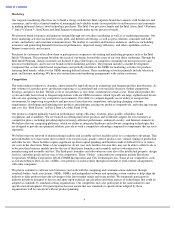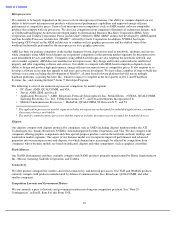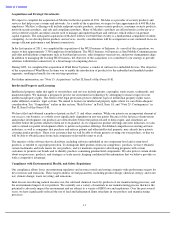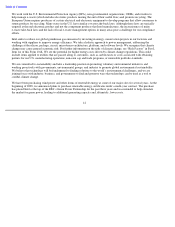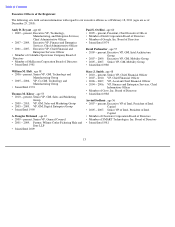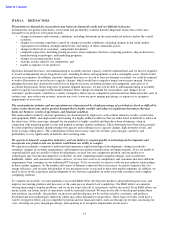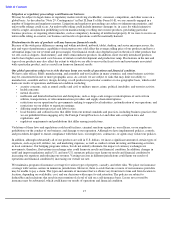Intel 2010 Annual Report Download - page 28
Download and view the complete annual report
Please find page 28 of the 2010 Intel annual report below. You can navigate through the pages in the report by either clicking on the pages listed below, or by using the keyword search tool below to find specific information within the annual report.
Table of Contents
We may not be able to enforce or protect our intellectual property rights, which may harm our ability to compete and harm
our business.
Our ability to enforce our patents, copyrights, software licenses, and other intellectual property rights is subject to general
litigation risks, as well as uncertainty as to the enforceability of our intellectual property rights in various countries. When we
seek to enforce our rights, we are often subject to claims that the intellectual property right is invalid, is otherwise not
enforceable, or is licensed to the party against whom we are asserting a claim. In addition, our assertion of intellectual property
rights often results in the other party seeking to assert alleged intellectual property rights of its own or assert other claims
against us, which could harm our business. If we are not ultimately successful in defending ourselves against these claims in
litigation, we may not be able to sell a particular product or family of products due to an injunction, or we may have to license
the technology or pay damages that could, in turn, harm our results of operations. In addition, governments may adopt
regulations, and governments or courts may render decisions, requiring compulsory licensing of intellectual property to others,
or governments may require that products meet specified standards that serve to favor local companies. Our inability to
enforce our intellectual property rights under these circumstances may harm our competitive position and our business.
We may be subject to intellectual property theft or misuse, which could result in third-party claims and harm our business
and results of operations.
We regularly face attempts by others to gain unauthorized access through the Internet to our information technology systems,
such as when they masquerade as authorized users or surreptitiously introduce software. These attempts, which might be the
result of industrial or other espionage, or actions by hackers seeking to harm the company, its products, or end users, are
sometimes successful. We seek to detect and investigate these security incidents and to prevent their recurrence, but in some
cases we might be unaware of an incident or its magnitude and effects. The theft or unauthorized use or publication of our
trade secrets and other confidential business information as a result of such an incident could adversely affect our competitive
position and reduce marketplace acceptance of our products; the value of our investment in R&D, product development, and
marketing could be reduced; and third parties might assert against us or our customers claims related to resulting losses of
confidential or proprietary information or end-user data, or system reliability. Our business could be subject to significant
disruption, and we could suffer monetary and other losses, including the cost of product recalls and returns and reputational
harm, in the event of such incidents and claims.
Our licenses with other companies and our participation in industry initiatives may allow other companies, including our
competitors, to use our patent rights.
Companies in the semiconductor industry often rely on the ability to license patents from each other in order to compete.
Many of our competitors have broad licenses or cross-licenses with us, and under current case law, some of the licenses may
permit these competitors to pass our patent rights on to others. If one of these licensees becomes a foundry, our competitors
might be able to avoid our patent rights in manufacturing competing products. In addition, our participation in industry
initiatives may require us to license our patents to other companies that adopt certain industry standards or specifications, even
when such organizations do not adopt standards or specifications proposed by us. As a result, our patents implicated by our
participation in industry initiatives might not be available for us to enforce against others who might otherwise be deemed to
be infringing those patents, our costs of enforcing our licenses or protecting our patents may increase, and the value of our
intellectual property may be impaired.
We invest in companies for strategic reasons and may not realize a return on our investments.
We make investments in companies around the world to further our strategic objectives and support our key business
initiatives. Such investments include equity or debt instruments of public or private companies, and many of these instruments
are non-marketable at the time of our initial investment. These companies range from early-stage companies that are often still
defining their strategic direction to more mature companies with established revenue streams and business models. The
success of these companies is dependent on product development, market acceptance, operational efficiency, and other key
business factors. The companies in which we invest may fail because they may not be able to secure additional funding, obtain
favorable investment terms for future financings, or participate in liquidity events such as public offerings, mergers, and
private sales. If any of these private companies fail, we could lose all or part of our investment in that company. If we
determine that an other-than-temporary decline in the fair value exists for an equity or debt investment in a public or private
company in which we have invested, we write down the investment to its fair value and recognize the related write-
down as an
investment loss. We also have significant investments in companies in the flash memory market segment, and declines in this
market segment or changes in management’s plans with respect to our investments in this market segment could result in
significant impairment charges, impacting gains (losses) on equity method investments, net and gains (losses) on other equity
investments, net.
When the strategic objectives of an investment have been achieved, or if the investment or business diverges from our
strategic objectives, we may decide to dispose of the investment. We may incur losses on the disposal of our non-marketable
investments. Additionally, for cases in which we are required under equity method accounting to recognize a proportionate
share of another company’s income or loss, such income or loss may impact our earnings. Gains or losses from equity
securities could vary from expectations depending on gains or losses realized on the sale or exchange of securities, gains or
losses from equity method investments, and impairment charges for equity and other investments.
17


